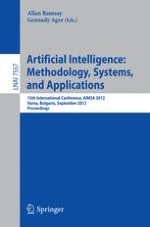2012 | Buch
Artificial Intelligence: Methodology, Systems, and Applications
15th International Conference, AIMSA 2012, Varna, Bulgaria, September 12-15, 2012. Proceedings
herausgegeben von: Allan Ramsay, Gennady Agre
Verlag: Springer Berlin Heidelberg
Buchreihe : Lecture Notes in Computer Science
